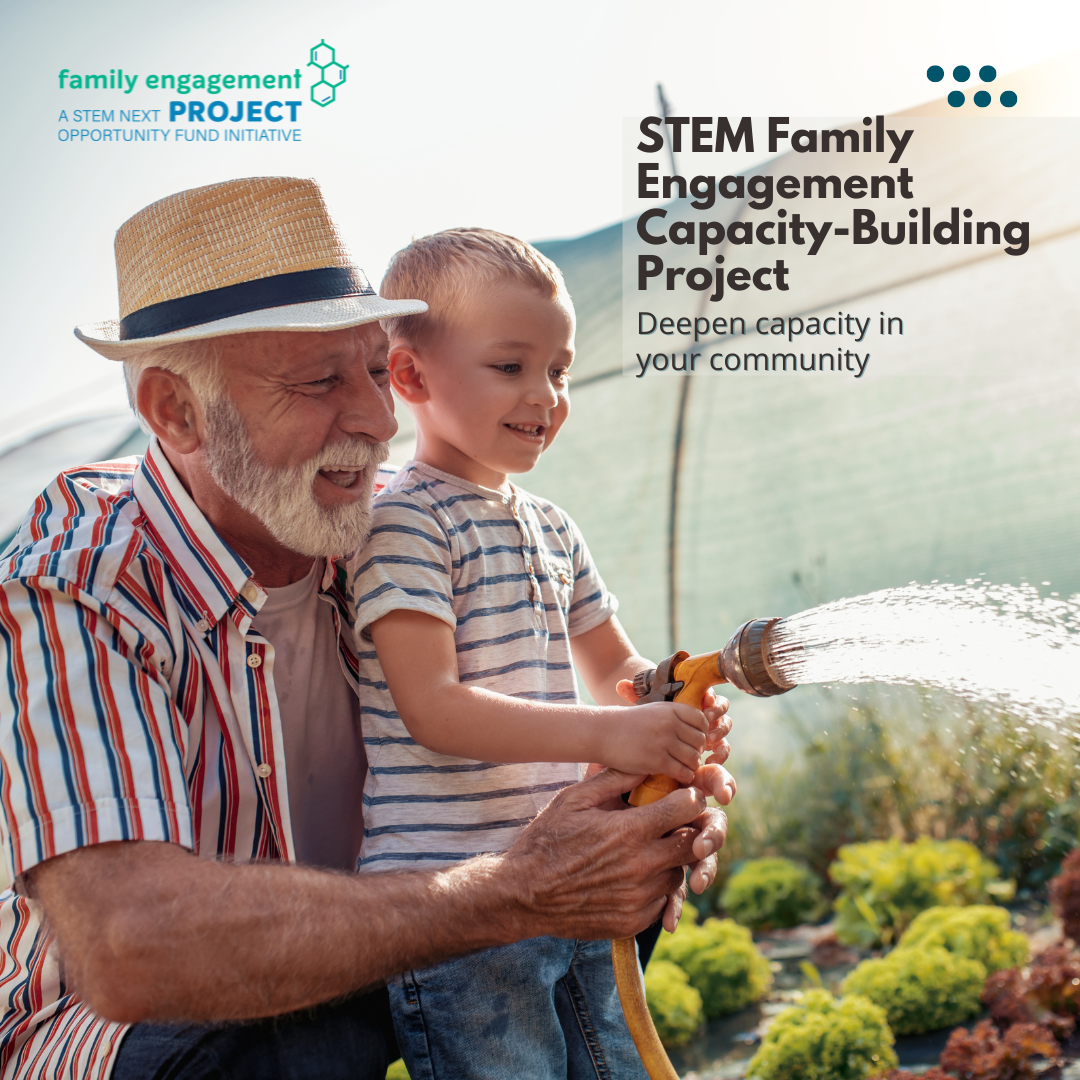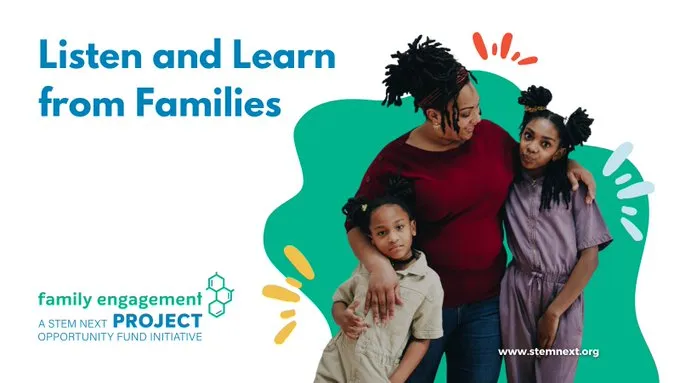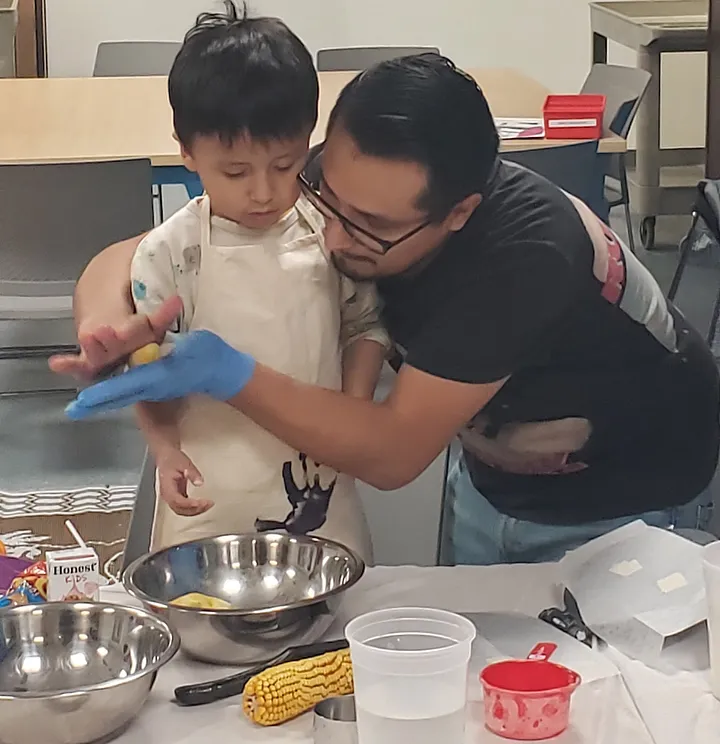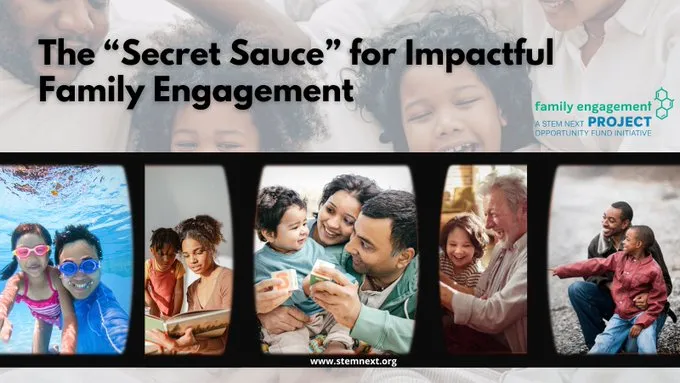Where does enchantment with stars and space or love for tinkering start? Building a telescope with a grandparent or working alongside a parent on a car maintenance project may launch a lifelong love of science, technology, engineering, and math (STEM). These opportunities can help inspire a passion for STEM and open exciting possibilities for the future.
STEM Next Opportunity Fund believes passionately in the power of families to inspire the next generation in STEM. STEM Next advances this commitment through The Family Engagement Project which supports research, resources, and training. This work is guided by STEM Family Engagement: A Planning Tool, which elevates best practices for impactful and equitable family engagement. The Planning Tool is organized around the CARE framework: Connect, Act, Reflect, and Empower.
This blog focuses on the “C” for Connect in the CARE framework. This framework organizes key ideas and strategies used to improve the capacity of program staff, families, and youth in support of STEM learning at home, in school, and in the community.
This blog is the fourth in the series, Growing STEM Leaders through Family Engagement. We offer four ideas to help programs build connections — inviting families into programs and making them feel welcome in STEM.
1. Welcome every family.
Before planning events or leading STEM activities, begin with plans to welcome every family. The programs that most successfully welcome and engage families embrace listening to and learning with families. Whether you are launching a new program, developing resources, or revisiting your work with families, make listening to families a priority. Listening: The “Secret Sauce” for Impactful Family Engagement offers ideas to welcome and empower families and improve STEM programs across diverse communities.
Welcoming families in action
The Cardinal Community Learning Centers, NE serves a rural community that has become increasingly diverse. A review of school district data revealed that 58% of students spoke a language other than English. To welcome these children and their families, the school district honors language and culture as valuable resources as they plan family engagement.
Cardinal Community Learning Centers takes a multifaceted approach to welcoming families and inviting them to STEM events. They send flyers home in children’s backpacks, distribute notices around town, and send home stickers the week of the event to remind families to participate. Staff talk with caregivers the day before these events. Program materials are translated. Staff who reflect the community’s diversity and serve as translators welcome families at STEM events. Families appreciate the effort that staff put into outreach and their commitment to welcoming all families. For more about this work and how to support diverse families, read the Program Spotlight of Cardinal Community Learning Centers by Patty Allen and Gil Noam.
2. Build trust and invest in relationships.
The CARE framework puts relationships at the forefront of family engagement. Dr. Karen Mapp of the Harvard Graduate School of Education advises that family engagement must start with trust. Practices like home visits, community walks, and phone calls home help build the foundation for trusting relationships and partnerships between educators and families.
April Hawkins offers strategies for Building Trust in a blog for ParentPowered. These include building two-way communication, bringing engagement into the community, taking a strengths-based approach, and creating culturally responsive relationships. We especially appreciate uplifting each family’s strengths and building on those assets.
Building trust and investing in relationships in action
For more ideas for building relationships with families, look to Family Creative Learning, which is a workshop series for families directed by Ricarose Roque with the Creative Communities research group. What we especially appreciate about Family Creative Learning is that it puts relationships at the center of its programs. You will find resources to engage families in computing that centered on love, care, and relationships in A Facilitator’s Guide to Family Creative Learning.
3. Celebrate diversity in STEM.
Delia participated in STEM Next’s Community of Practice on family engagement. This experience along with resources like The Planning Tool offered ideas for how to connect with families at the New York Hall of Science (NYSCI). This Multigenerational Tinkering video with Delia shows the perfect example of STEM that honors culture and STEM in the everyday lives of families. Every time we watch how Delia connects with families with food — making tortillas, sharing a meal, discovering STEM — we learn something new about the power of encouragement.
The tortilla-making activity focuses on the intersection of STEM education and cultural responsiveness. This approach aims to make science more relatable to members of the NYSCI community, emphasizing the importance of cultural context in STEM learning.
Participants were guided through the hands-on process of crafting traditional Mexican tortillas from scratch providing them with a tangible and engaging experience. One of the key learnings from this activity was the importance of integrating STEM principles within a culturally significant context. Children and families not only gained practical skills of making the tortillas but also discovered the scientific principles behind the process, such as the chemistry of dough formation and the physics of heat transfer during cooking. Also, the process of making tortillas involves a combination of scientific principles and mathematical calculations.
This activity exemplifies the power of cultural responsiveness in STEM education, illustrating how incorporating cultural practices from around the world into learning activities enhances engagement and understanding. By connecting scientific concepts with familiar cultural traditions from members in NYSCI’s community like making tortillas, NYSCI successfully demonstrated the potential for making STEM education more inclusive and accessible to diverse communities.
4. Commit resources for building connections with families.
Training and time are required for the family engagement practices described in this blog. Regular phone calls, updates on children’s progress, and informal conversations during drop off and pick up are opportunities to connect with families. Allocating time for staff to engage in these activities is vital.
Not everyone working with youth in STEM programs is prepared to engage with caregivers from diverse backgrounds. STEM Next offers training to equip educators with the tools needed to support connections for impactful family engagement. In communities of practice, participants come together over an extended period to reflect, share strategies and resources, and create an action plan with partners. The CARE Framework and STEM Planning Tool provide practical ideas for putting research into action and real-life examples of ways to overcome barriers and connect with families.
The Essential Funders’ Guide to STEM-Focused Family Engagement advocates for increased funding for program quality, access, and professional development. This Guide offers ideas to empower families to support their children’s learning, close opportunity gaps in STEM, and ensure access to high-quality learning opportunities that every child deserves. Let’s make sure that making connections and building relationships are priorities in this work.
By: Linda Kekelis and Delia Meza
***
Linda Kekelis: I am an advisor on family engagement for STEM Next. I’ve devoted my lifetime to supporting families and educators in encouraging youth in STEM. I am grateful to all the families I met over the years who shared their hopes, dreams, and ideas that have helped me appreciate the power of family engagement. I am grateful to partners like Delia who share their experiences and help me see the bright spots and understand family engagement in diverse communities.
Delia Meza: I am the Director of Family Learning and Community Partnerships at NYSCI. I have over 20 years of experience developing programs that are responsive to community needs and children’s learning. I have a deep understanding of early childhood programming and family engagement best practices. I am an Association of Science and Technology Centers Diversity and Leadership Development Fellow. I hold an MA in Leadership in Museum Education from Bank Street College of Education.
For STEM Next, family engagement is essential in accomplishing its big goal of inspiring 20 million more young people with STEM opportunities by 2027. STEM NEXT supports family engagement by supporting networks of organizations that offer STEM programs in out-of-school time. With case studies, blogs, and white papers STEM Next highlights promising practices and research. These include Changing the Game in STEM with Family Engagement and Field Guide: How to Host a Community of Practice.
The STEM Family Engagement: A Planning Tool CARE framework was developed by the Institute for the Study of Resilience in Youth with support from STEM Next and with participation from researchers, practitioners, caregivers, state network leads, and others with expertise in STEM, family engagement, and equity.





